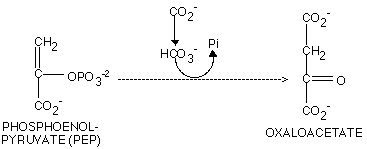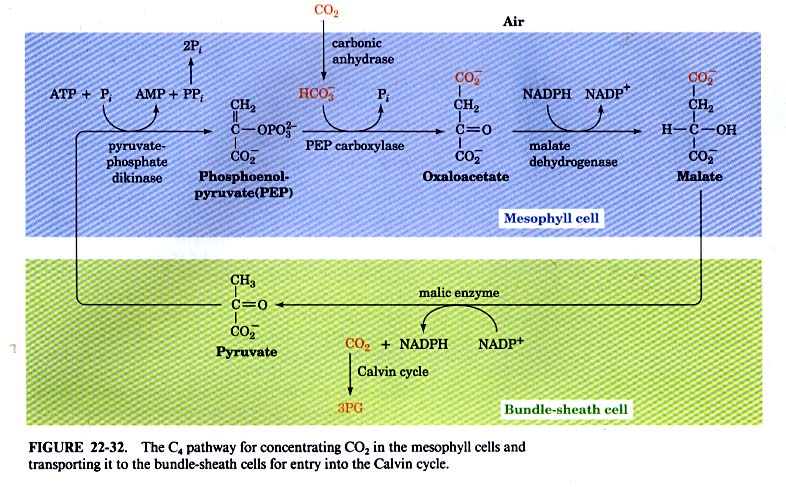|
|
|
|
|
|
|
Phosphoenolpyruvate Carboxylase
The catalytic role in C4 Metabolism
|
|
|
|
Introduction: |
|
|
|
Phosophoenolpyruvate Carboxylase (PEPC) in an enzyme primarily produced in bacteria, protozoa, algae, and plants, and absent in yeast, fungi, and animals. The catalytic role of PEPC is the fixation of carbon dioxide with phosphoenolpyruvate to produce oxaloacetate and inorganic phosphate. The catalytic role of PEPC displays a anaplerotic function by replenishing C4-dicarboxylic acids in the citric acid cycle. PEPC essentially feeds oxaloacetate into the TCA cycle due to a depletetion from synthesis of various cellular components. Figure 1 shows the basic catalytic reaction performed by PEPC. |
|
|
|
 |
|
|
| Figure 1 |
|
|
|
PEPC plays an important role in C4 and crassulacean acid metabolism plants. C4 plants occur primarily in tropical regions where they grow faster under hot and sunny environmental conditions than other plants that grow in cooler climates. C4 plants fix carbon dioxide in the form of four-carbon acids, whereas other plants are called C3 because they fix carbon dioxide in the form of three-carbon acids (Voet, 1995). Figure 22-32 from Voet, page 658, shows how PEPC is important in the C4 pathway of tropical plants. The pathway is isolated in the mesophyll cells of the plants and is present as the phosphorylated form during the day. As shown in figure 22-32, PEPC provides oxaloacetate to malate dehydrogenase which provides malate to the bundle-sheath cells. The malate in oxidized to provide pyruvate and NADPH for the calvin cycle. The pyruvate then circles back into the mesophyll cells and pyruvate phosphate dikinase converts it into phosphoenolpyruvate for PEPC and the reaction starts all over again.
|
|
|
 |
|
|
| PEPC also plays a crucial role in CAM (crassulacean acid metabolism) plants such as pineapple and cactus. These plants use the C4 pathway to carry out photosyntheis with a minimal water loss from evaporation. CAM plants absorb carbon dioxide at night and store the carbon dioxide by synthesis of malate through the reactions of the C4 pathway. During the day the malate is broken down to form carbon dioxide necessary for the Calvin Cycle.
The primary focus of this paper is the catalytic role of PEPC in the C4 pathway. Tropical plants and E. coli use PEPC as an essential enzyme for catalyzing metabolic reactions responsible for the maintenance of the citric acid cycle. This paper will look at the primary structure of PEPC from E. Coli and the catalytic site along with the allosteric site of PEPC in plants and E. Coli. The PEPC of both plants and E. coli have the same ancestral origin with 31% and 52% amino acid identities and similarities (Yasushi et.al, 823). The sturcture can be interpretated for both species.
|
|
|
|
HOME |
|
|
|
|
|
|
|
|
|
|
|
|
|
|
|
|

